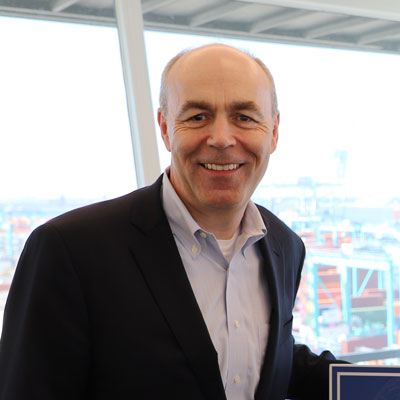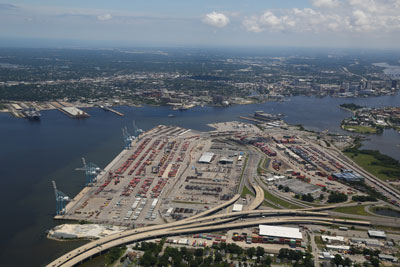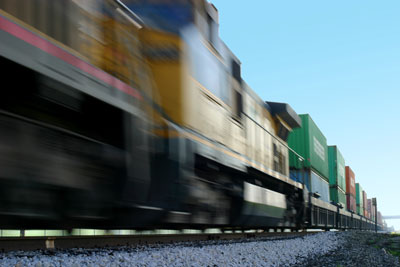Manifest destiny
Port continues cargo growth under new leadership
Manifest destiny
Port continues cargo growth under new leadership
Taking on a new job during a pandemic could spell rough waters, particularly if the job relies on global commerce.
But the past eight months largely have been smooth sailing for Stephen Edwards, the new CEO and executive director of the Virginia Port Authority, which oversees the Port of Virginia.
Edwards came onboard in January, relocating from the West Coast where he was CEO of Los Angeles-based TraPac LLC, which operates container terminals and provides stevedore services in California and Florida. He replaced John Reinhart, who retired in January after a seven-year tenure during which he oversaw major revenue growth and expansion at the port, which had been faltering financially before Reinhart took over.

Edwards inherited a modernized port that continues to see record increases in shipping volume, despite a challenging year for the movement of goods and services. Also, the port is moving forward with numerous projects to increase its business, with the potential to benefit economic development efforts in Hampton Roads and across the state.
During the 2021 fiscal year, which ended June 30, cargo volume for the Port of Virginia, the fifth largest container port in the United States, was up by 16.8% compared with the prior year. Though cargo volume was lower in July and August 2020 due to the pandemic, the port processed 3.2 million TEUs (20-foot equivalent unit containers, a standard unit of cargo capacity) during fiscal 2021, compared with 2.75 million TEUs in the prior year.
Also, loaded import TEUs were up 18.6%, compared with the previous year, while rail containers rose 16.7% in fiscal 2021.
Strong e-commerce buying patterns are one of the main factors driving cargo volume increases.
“One of the outcomes of changing behavior during the pandemic has been an extraordinary boom in buying goods,” Edwards says. “There’s been a significant uptick in shipments in home improvements, whether it’s furniture or refrigerators or bathroom improvements.”
Additionally, cargo shippers “are winning confidence in Virginia as a port,” says Edwards. “We have this strong market going, and we have had people choosing to use us because we have been able to provide good service.”
Digging deep
The port’s growing business sets the stage for one of its major projects — dredging the commercial channels that serve the Norfolk Harbor to 55 feet by 2024 to accommodate super-size cargo vessels, as well as two-way shipping traffic. The $350 million project also will widen the channels to more than 1,400 feet in specific areas.
In July, the port authority board awarded a $39.5 million contract to Great Lakes Dredge & Dock Co. LLC to dig on the east side of the Chesapeake Bay Bridge-Tunnel. The contract builds on work by another company, Weeks Marine, which is dredging the west side.
In May, the port welcomed the CMA CGM Marco Polo, thought to be the biggest container ship ever to call in Virginia, at nearly 1,300 feet in length (more than four football fields long) with a capacity of 16,022 TEUs.
Deeper waters are needed for bigger ships.
Deepening and widening port channels “speaks directly to our customers, the ocean carriers,” says Joe Harris, spokesman for the port. “In two years, you are going to be able to bring in bigger ships and bigger ships with more cargo.”
Once complete, the channels would be able to simultaneously accommodate ultra-large container vessels. Making room for two-way traffic will increase shipping efficiency, says David White, executive director of the Virginia Maritime Association, which promotes international and domestic commerce through Virginia’s ports.

Right now, when an ultra-large container ship calls on the port, the channel is restricted to one-way traffic for three to four hours, he says. Ships sailing in the opposite direction must wait until the one-way traffic restriction lifts before continuing.
Once the dredging project is complete, two-way traffic will be allowed at all times.
Also, this fall, the port will break ground on a $44 million expansion project to double the capacity of the railyard at its Norfolk International Terminals. The bulk of the work will focus on construction of 10,700 feet of new track inside the terminal.
The Norfolk rail operation can handle 368,000 containers annually. In the next decade, the port projects that it will need capacity to process an additional 200,000 containers for export. Edwards says the expansion will add about 80% more rail capacity at the Norfolk facility.
As of October 2020, 34% of the port’s total volume moved to market via double-stack rail service.
A $20 million grant from the U.S. Department of Transportation‘s 2020 Port Infrastructure Development Discretionary Grants Program will help fund a portion of the Norfolk rail expansion.
InterChange Group Inc., a storage and supply chain logistics company based in Mount Crawford, plans to take advantage of this expanded rail capacity. It’s been using the port since 2005 to transport packaging materials, cabinets, frozen fruit, poultry and more via truck and rail.
InterChange has a new cold storage facility, and the company is making plans to ship more frozen foods via the port’s truck and rail services.

“We expect more rail movements into the future, and the Port of Virginia is a leader in rail movements already,” says Devon Anders, president of InterChange Group.
Plus, moving items by rail keeps trucks off the road, which reduces traffic congestion, he says.
Trade wind
The port has another key goal for the future — to become the hub for Virginia’s developing offshore wind industry.
In July, the port’s board agreed to lease 70 acres at its Portsmouth Marine Terminal to Dominion Energy, which plans to build its $7.8 billion Coastal Virginia Offshore Wind farm 27 miles off Virginia Beach’s coast, erecting about 180 wind turbines. The Portsmouth terminal would be used as a staging space to deploy equipment for building the massive turbines, each of which will tower 800 feet above the ocean surface. Dominion has already installed two pilot wind turbines, each 600 feet high.
“It really is an enabling step to help the whole [offshore wind] industry develop in Hampton Roads,” Edwards says.
Hampton Roads is a prime area for this kind of industry to grow because it has accessible ports and employs a workforce that is similar to the one already employed by the region’s maritime and Navy facilities, says Matt Smith, director of offshore wind business development for the Hampton Roads Alliance.
“When we talk about the Port of Virginia, one of our natural advantages is our port infrastructure. We feel like it’s the best and well suited to support the offshore wind industry on the East Coast,” he says.
There will be at least 900 jobs needed to support various stages of developing, manufacturing, installing and operating the Coastal Virginia Offshore Wind project, according to an economic analysis conducted by Glen Allen-based Mangum Economics for the alliance. Also, it’s estimated that for each gigawatt of new offshore wind energy capacity, it will require roughly 3,100 workers in Hampton Roads, and the Dominion wind farm plans to generate 2.6 gigawatts.
“It’s not often that you have the chance to be one of the hubs of the industry that has the potential to create a lot of jobs and new development in the region,” Smith says. “We’re excited about the industry for both of those benefits.”
The Portsmouth Marine Terminal is well positioned to support the Dominion project due to its proximity to the ocean, as well as the fact that there are no bridges that ships must pass under, making it easier to ferry large wind turbine components, White says. “We have tremendous advantages in terms of infrastructure,” he adds.
But all of Virginia, not just Hampton Roads, stands to reap economic benefits from the development of the offshore wind industry. The economic impact of the project has the potential to trickle throughout the state, White says. For example, the Dominion wind farm turbines will need companies to install service elevators for maintenance, White says, and those may come from outside the region.
The Port of Virginia offers numerous benefits for Virginia’s economic development, whether in offshore wind development or other work. But one needed ingredient to help the port continue to grow and boost Virginia’s economy is drawing more large manufacturing companies to the commonwealth, says Stephen Moret, president and CEO of the Virginia Economic Development Partnership. He also serves on the port’s board.
“If you imagine, a huge portion of the business of the Port of Virginia is not starting or ending in Virginia,” Moret says. “We are missing out on opportunities that are not in the port’s control. Attracting more of these large projects to locate in Virginia, they would be great customers for the port and maximize the return on investment.” ν
<














